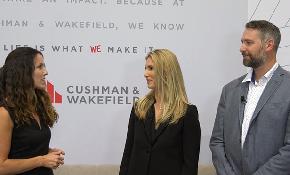 “You want to get ahead of the curve if you’re the Fed,” McCarthy says.
“You want to get ahead of the curve if you’re the Fed,” McCarthy says.
NEW YORK CITY—A modest increase in the short-term federal funds rate was generally expected as an outcome of the Federal Reserve’s December meeting that concluded on Wednesday, and so it came to pass. Arguably more telling were signals in the Federal Open Market Committee’s statement that Wednesday’s quarter-point increase could be followed by multiple increases next year. Not so long ago, there were at most two rate hikes on the Fed’s long-time horizon through 2018.
“What the Fed actually ends up doing will very much depend on the state of the economy at the time they meet,” Cushman & Wakefield’s Ken McCarthy tells GlobeSt.com. “A year ago, the general expectation was that by the end of this year, the federal funds rate would be somewhere between 1.25% and 1.5%.” In fact, Wednesday’s move by the Fed will bring the rate into a range between 0.50% and 0.75%. “Obviously, we didn’t get there.”
What got in the way of meeting that expectation was a world of socioeconomic volatility, from the Chinese stock market slump to the unexpected outcome of the Brexit referendum. Looking into next year, “if everything goes as planned, it will be appropriate to raise interest rates more rapidly,” says McCarthy, principal economist with Cushman & Wakefield. “The economy’s in good shape, the unemployment rate is down, job growth is still healthy and inflation is creeping up—you want to get ahead of the curve if you’re the Fed. So unless there’s a reason not to, I would expect the Fed to become more aggressive in 2017 than they were in 2016.”
When the economy is doing well, says McCarthy, the FOMC are “the ones who are supposed to remove the punch bowl from the party. The fact that they haven’t been doing so thus far is more reflective of the slow growth in the economy.” Part of the reason for the uptick in expectations of more frequent rate increases is that, as Fed chair Janet Yellen mentioned in her news conference following the announcement, a few members of the FOMC have suggested that fiscal stimulus was a possibility. “So there’s a sense that there may be more upside on the growth.”
Conversely, higher interest rates increase the cost of capital and make it more difficult to raise capital to pay higher prices, and McCarthy acknowledges that after a few rate hikes, some investors may feel the cumulative effect. “Although commercial real estate returns are lower than they were, they’re still ahead of long-term interest rates,” he says. “If that starts to change, that could have an impact on commercial real estate. It will be partly offset by the expectation that rents will increase more rapidly in a strong economy.”
How keenly buyers feel the impact of multiple rate increases depends in part on what kind of investors they are, says McCarthy. “If they’re buying property for short-term yield and plan to turn it over fairly quickly—those are the investors who will probably have more of a challenge,” he says. “You have to have the economy as sort of a tailwind. Your margin, in terms of the rate at which you’re borrowing compared to the rate of return on the property, will narrow somewhat in a rising rate environment. You have to work on improving your return by improving the property, so it’s more of a value-add market as opposed to just a cap rate market.”

















 Copyright © 2024 ALM Global, LLC. All Rights Reserved.
Copyright © 2024 ALM Global, LLC. All Rights Reserved.